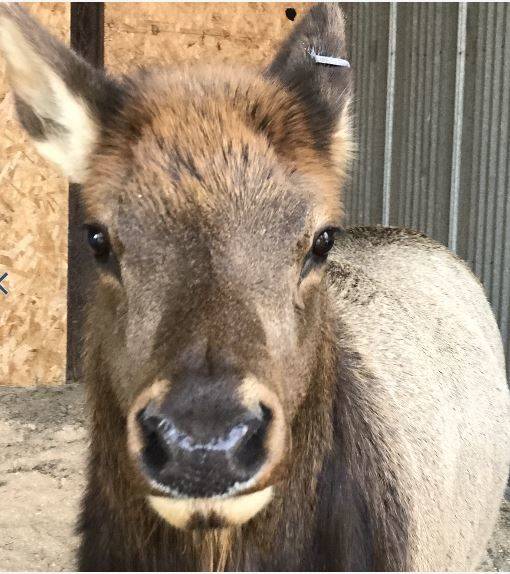SELAH – Despite Washington Department of Fish and Wildlife (WDFW) managers’ best efforts to give “Buttons” the elk a chance at a life among other wild elk, she is now on the way to a new home at Woodland Park Zoo.
Habituated to humans from a young age, the elk was a common visitor to rural homes and ranches in Cle Elum, achieving celebrity status in the community.
“People petted her, hand fed her, put children on her back,” said Scott McCorquodale, WDFW regional wildlife program manager.
While the story may seem heartwarming to some, the results of taming Buttons were far from good for the elk or for the public.
“There are untold ways a situation like this can end badly, and it usually does,” said McCorquodale.
After reports of damaged property, signs of aggression toward people and pets, and a garden hose wrapped around the animal’s neck, WDFW personnel immobilized and moved the elk to the Mellotte Feeding Station near Selah on Feb. 1 to see if she would integrate with the wild herd there.
This is not an uncommon story. “Each spring, the Department works to make sure people leave fawns, elk calves and other wildlife alone if found in the wild,” said McCorquodale.
After five weeks, the attempt to re-wild the elk failed, with Buttons ignoring the herd and preferring to gravitate toward human settlements and all the potential for trouble that necessitated the move.
“People’s intentions were good, but the sad truth is that this elk lost its chance to be wild,” said McCorquodale. “We wanted to see her interact more with elk and less with people for her own good and for public safety,” he added.
Often the mother of an animal presumed orphaned is off feeding and soon to return, said McCorquodale. “Even when the public is certain the animal is orphaned, taming is never a good option,” he said.
Instead McCorquodale recommends a call to a regional WDFW office, or a licensed wildlife rehabilitation expert (https://wdfw.wa.gov/conservation/health/rehabilitation/how_to_find.html).
“Licensed rehabbers have the facilities and know the techniques to raise an orphaned animal, without creating unnatural dependence on humans,” said McCorquodale.
As it stands, it’s very hard to find a place that will take a tame elk.
“We were so lucky to benefit from the goodwill of Woodland Park Zoo,” said McCorquodale. “It is exceedingly rare that we would be able to find a place for a habituated deer or elk. Organizations we called rejected our offer, and placing a tame elk at a zoo is simply not an option in the vast majority of cases.”
Woodland Park Zoo currently has a herd of elk consisting of two females and one male.
Introductions for all new animals require a careful, deliberate process and patience, said Jennifer Pramuk, an animal curator at Woodland Park Zoo.
“As with all introductions, we will follow the cues of Buttons and the other elk,” said Pramuk. “Our animal care staff is very experienced so we’re hopeful we can socially integrate Buttons with our herd,” she added.
“While it’s unfortunate she became habituated to humans, having Buttons at the zoo will allow our staff to talk with guests about her situation and the downside to taming animals found in their natural range,” said Pramuk.
McCorquodale is only one of a small cadre of agency employees that has spent more than a month trying to extend this elk’s life and keep her out of trouble.
“I know this elk will get great care at Woodland Park Zoo, and she will live with a small number of her own kind, said McCorquodale. “Beyond that one bit of good, I hope her story results in more commitment for people not to let this happen again.”
The Washington Department of Fish and Wildlife is the primary state agency tasked with preserving, protecting and perpetuating fish and wildlife and ecosystems, while providing sustainable fishing and hunting opportunities.



